The versatile flower-filled blue plumbago will satisfy plenty of our needs in the garden. Do you need a shrub, some erosion control, a privacy hedge, something to climb a wall, trail down a terrace, or just fill a pot? Our old favorite, the plumbago auriculata, can do all of this!
Plumbago is a herbaceous, evergreen shrub, mounding in shape and with sprawling branching that allows us to use it as a climber, or trailer wherever we need it. Additionally, it is covered all growing season with plentiful blue blooms.
Plumbago Auriculata-Hardiness Zones
- This low-maintenance shrub is hardy outdoors in zones 9-11 where you can anticipate blooms for all 12 months.
- In zones 7-8 you will have a long season of blooms and can bring container plants into a protected building or garage or take cuttings.
- In colder climates use plumbago as an annual or bring some indoors as a house plant.

Plumbago will also serve as a houseplant for the winter, and we can overwinter the plant with some climate-appropriate care. To use your blue plumbago indoors for the winter, pot it before your first frost and keep it in a sunny room.
‘How to Acclimate Plants Between the Garden and Indoors.’
Plumbago auriculata-The Blue Plumbago’s Versatility
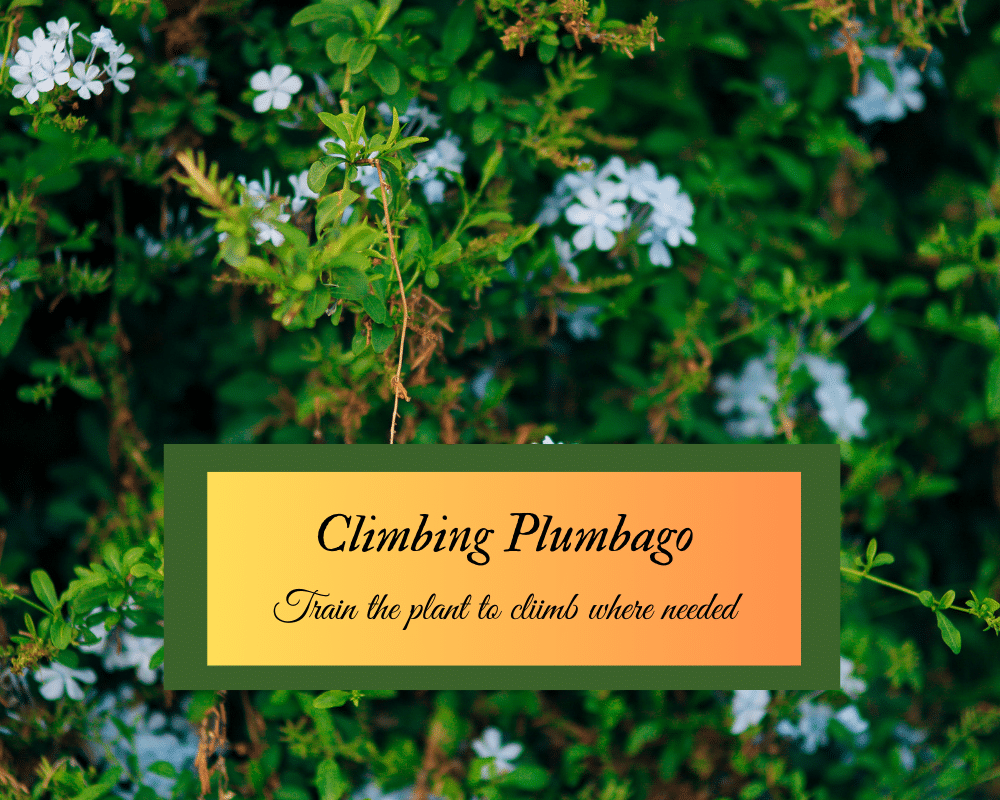
Plumbago auriculata is a sprawling shrub that is simple to maintain as a mounding shape and as a bonus, can also be used as a climber. Suitably pruned, the plant can reach 6-10′ in height (2-3m.) and spread from 8-10′ wide (2.5-3m.) Plumbago is remarkably resistant to pests and diseases, and once established is drought tolerant, thus making it a low-maintenance addition to your garden.
How To Help Your Plumbago Climb
Plumbago auriculata is a scrambling climber similar to bougainvillea or climbing roses. The plant will send out long bendable stems but in order to keep it on your trellis you will need to tie it up as it grows.

The plumbago also is beautiful as a trailer. Grow it on the edge of a terrace or at the top of a wall. It will trail down in a beautiful drip of blue.
How We Got The Plant
Plumbago auriculata is native to South Africa and performs best in similar mild climates. There are two plant Genus named plumbago with about 10-220 species. The plant we are interested in here is the Plumbago auriculata, the beautiful blue shrub and climber.
When planting in a Florida garden you can check the UFlorida list of ‘Florida Friendly Plants.‘ These plants, even if not native to Florida are considered well suited to the local environment.
Florida Friendly Landscaping Guide and Planting List
Plant Features
Plumbago has bright green foliage of medium density and flowers, the thin stems are vine-like and will maintain a delicate appearance even when used in a mass or as a long hedge.
The flower, most commonly light blue, is produced on rounded, terminal clusters. Each five-petaled flower, one to three inches in diameter emits a slight but pleasant scent.
Flower Colors
The most common color is the pastel blue we associate with the plumbago plant but there are some other options if you take the time to find them via your dealer or grower. Look for these varieties, the colors are dramatic.
- Plumbago auriculata ‘Crystal Waters’, vivid bright blue.
- ‘Royal Cape’, strong dark blue.
- ‘Imperial Blue’, medium blue.
- ‘Dark Blue’, as specified.
- ‘White Cape’-white.
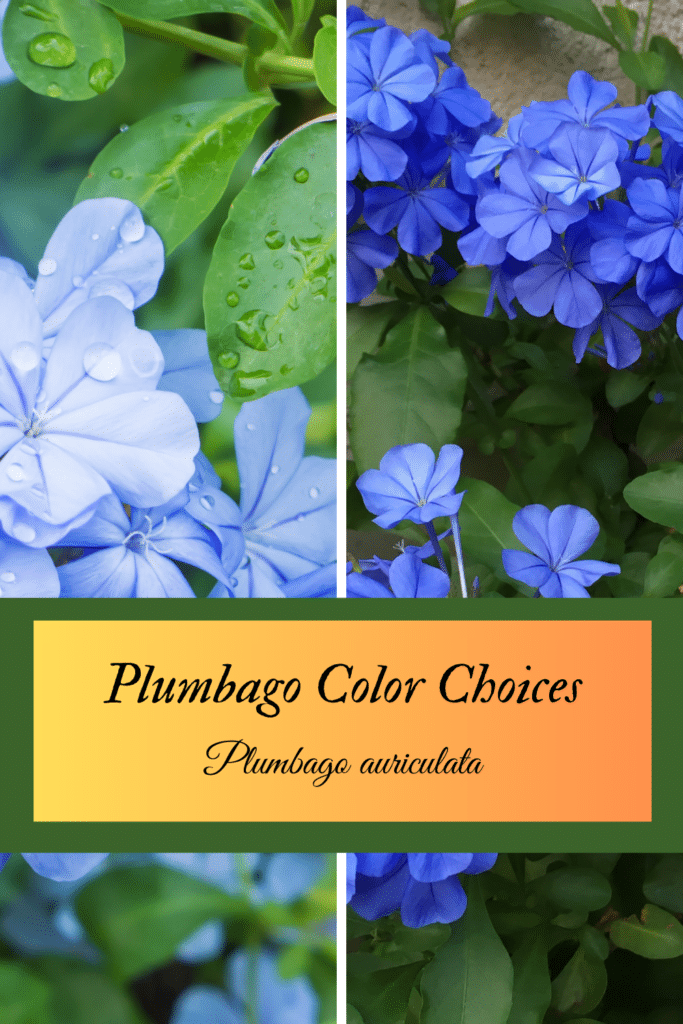
Using Blue In The Garden
We all love to find the comparatively rare flowers that bloom in blue for our gardens. In subtropical and tropical climates blue flowers are especially hard to find. Blue blooms are a beautiful addition to gardens and lend an air of coolness and repose.
This will help with adding blue: ‘Gardening in Florida-How to Add Blue’
Here’s how to read the botanical names: The capitalized word in italics is the genus name, Plumbago. The second italicized word, auriculata, is not capitalized and this tells you that you are reading the species name. A name that follows in regular letters inside a single quotation mark indicates not just a variety but an intentionally produced greenhouse plant.
The plant name Plumbago implies that it has a lead-like appearance, the species name auriculata means it is ‘ear’like and that is a reference to how the leaf is attached. The plumbago has a long history in our gardens. (Pliny The Elder, 23-79 AD) one of the earliest botanical writers gave it the name that implies lead. He is also an important source of what we know about Roman gardens and how they imported, developed, and used plants in their lives.
You will also see this plant marketed as skyflower, cape plumbago, and leadwort.
For more information try this: ‘Latin for Gardeners-How to Read and Remember Plant Names’
Pollinator And Wildlife Issues
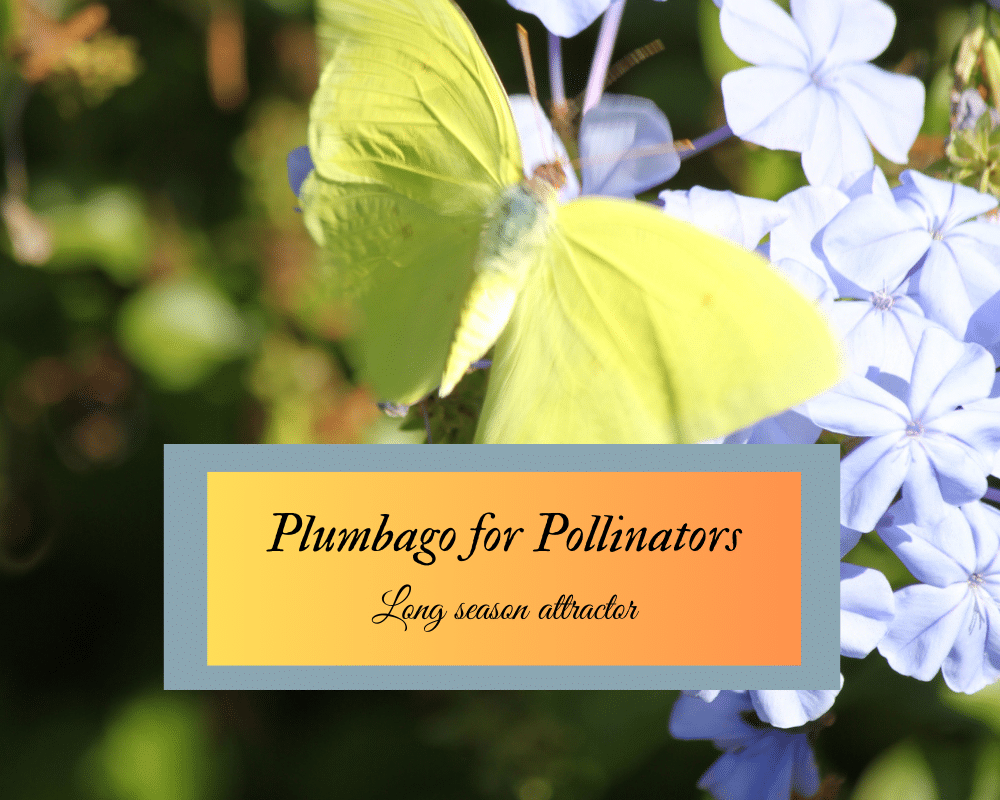
The sweet and slightly tubular flowers are attractive sources of nectar and pollen for butterflies, bees, and hummingbirds. With its long bloom season, it will provide for pollinators over the long term. A bonus is that the plant is not appealing to deer and rabbits. The deer-repellent features of a plant are usually bitter taste, sharpness, strong scent, or a fuzzy surface.
In the case of plumbago the plant is irritating to the touch and deer will avoid them. Some people notice contact dermatitis when handling the plumbago. If so gloves will help.
Ways To Use This Plant
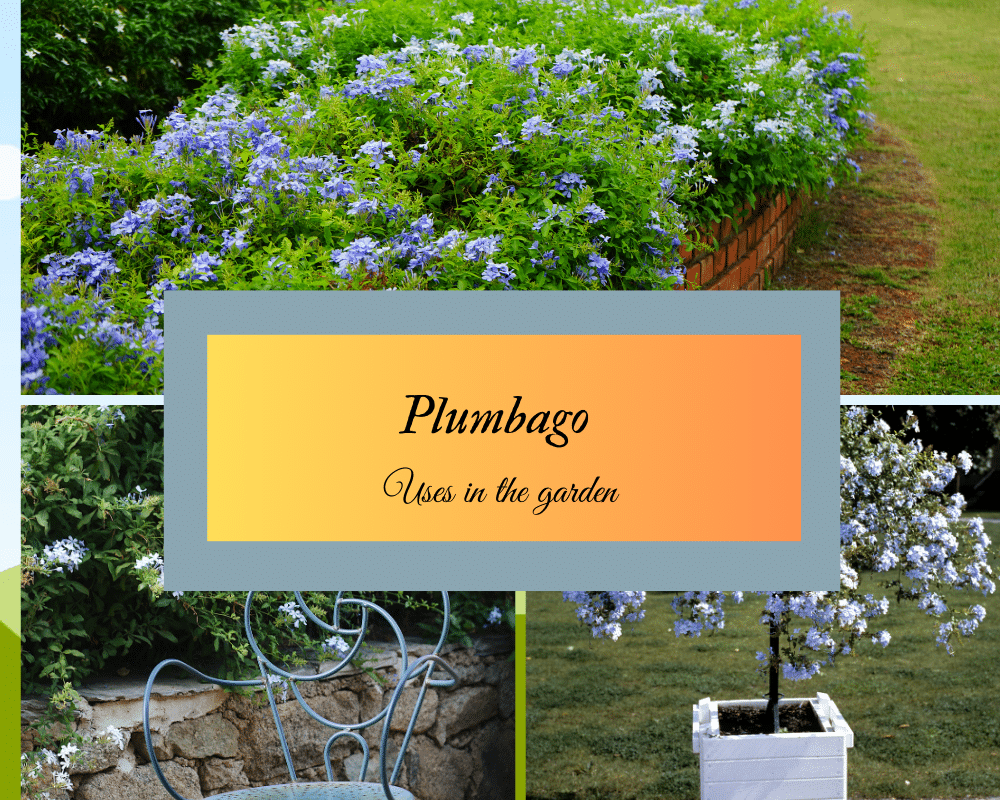
- An attractive mounding shrub fills empty spaces
- A foundation plant, also around decks, patios, porches, and swimming pool screens
- Surround palms with them, tall palms should provide enough light
- A container plant
- A house plant
- Plumbago will cover hillsides and prevent erosion
- Plumbago makes a plant to train up a trellis, covered in blue
- It is very beautiful trailing down a wall or fence
How To Grow Plumbago
Use plumbago in full sun (or with some afternoon shade) the plant will flower best in sunlight.
How To Plant Plumbago
You can plant the plumbago in its hardiness zones 9-11 at any time of year. Wherever you are, pick a spot with 6-8 hours of sunlight and dig a hole deep and wide enough to enclose the plant roots. Partially fill the hole with organic matter, add timed-release fertilizer to start your plant, and dig in the plant. Water the new plant completely. This will help you ensure that there are no (fatal) air holes under the soil.
Good Companion Plants For Plumbago auriculata
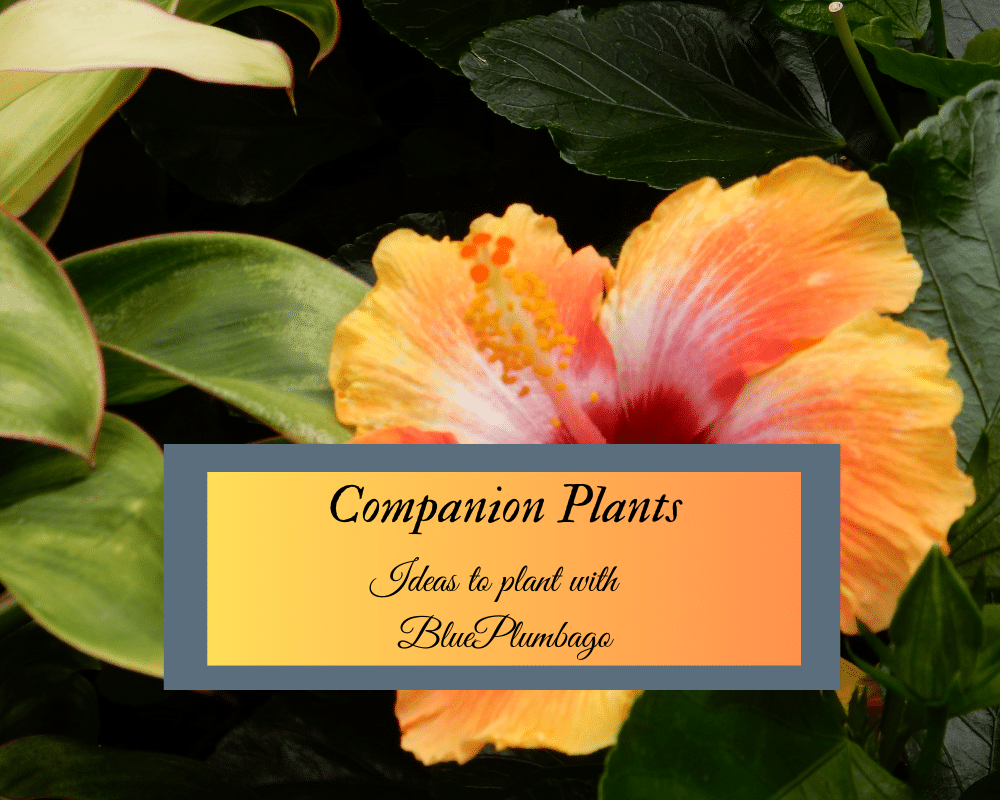
Plant your plumbago with other sun-loving plants with similar requirements for soil, food, and water.
The blue flowers are attractive in several color combinations. One particularly attractive combination is blue with shades of tangerine, peach, or orange. Here are some plants that will work with your plumbago. Any of them are handsome with the easier-to-find pastel blue and very dramatic with the bright blue shades.
- Nora Grant Ixora, this rounded shrub is desirable for size and shape as well as its similar pH preference. Commonly found in rose, yellow, pink, and white you can also find a light shade of tangerine.
- Hibiscus, use trees or shrubs to meet your goal, there is a wide choice of colors, shapes, and forms such as double blossoms, extra large blossoms, and weeping forms.
- Panama Rose
- Bush Allamanda for a handsome yellow bloom
- Silver Buttonwood
Light Conditions

As the plant prefers full sun you will find that the best blooms, flower and foliage color, and healthiest branching come from warm temperatures and full sun. In our zone 10b, tropical climate, we can use some afternoon shade. Plumbago will grow in shade but the plant will be less full and with fewer flowers.
Soil
Plumbago auriculata grows easily in well-drained, organically rich, and fertile soil. During the growing season, it favors consistently moist soil but will accommodate poor soil and drier conditions.
Water

Water plants in the hole when planting and while the plant is being established, water it twice a week unless conditions such as heavy winds and heat require more often, Weekly watering once established should be sufficient.
The plumbago plant has a root system that will reach at least two feet in depth and the plant will spread slowly via rhizomes. This suggests to us that each watering session should put down enough water to reach the roots.
Nutrition
Successful growers fertilize with a general-purpose fertilizer every two months to quarterly. The plant will grow without additional fertilizer.
Pruning and Maintenance
Planted in full sun and well-drained soil, plumbago is a fast-growing plant and can be pruned to your preferred size any time during the year. Prune plumbago, only enough to keep it at the size you prefer. Hand pruning is sufficient but the plant can be pruned mechanically. Follow the basic pruning rule of never removing more than 30% of the plant’s mass.
*Important note: when performing a hard pruning (removing nearly 30% of the plant, remember to water the plant well before you begin to prune.
Pests And Diseases
Plumbago auriculata is resistant to both pests and diseases. Mites and cotton cushion scale are an occasional problem. As plumbago prefers a pH of 5.8-6.2 slightly acidic to neutral, a highly alkaline soil can result in yellow foliage.
Growing Your Versatile Blue Plumbago In Containers
The Plumbago auriculata will grow successfully in containers and will remain smaller. Moveable pots can go indoors in unheated shelter in zones 7-8 and in colder zones, smaller containers or cuttings can be used as house plants.
Container plants will require superior drainage. Use a balanced potting mix and some experts will add some sand to this to enhance drainage. You can grow plants in containers of various materials.
- Plastic containers are light and easiest to carry.
- Sealed ceramic plants are available in many styles and colors, as you choose. Heavy to carry they are also the most resistant to storm damage, especially in hurricanes. If your container is too big to move indoors, you can root some cuttings to make new plants to grow indoors over the winter.
- Unglazed terra cotta pots provide the best drainage and the color is appealing with the blue blossoms.
Summary,
‘A garden is a complex of aesthetic and plastic intentions;
and the plant is to a landscape artist,
not only a plant-rare, unusual, ordinary or
doomed to disappearance-but it is also a color,
a shape, a volume or an arabesque in itself.’
-Roberto Burle Marx
A garden is our chance to create a little work of art, and as such it’s a lot more than the plants inside it. But the plants we choose are a big part of our success in making a garden, and when we find one as versatile and useful as the simple blue plumbago we help ourselves by learning all the ways to use it and apply our knowledge to the garden!
Happy digging, or as Cicero said ” if you have a garden and a library, you have all you need.’
Resources You Can Use
Plumbago auriculata, Missouri Botanical Garden: Plant Finder
Plumbago: University of Floridahttps://gardeningsolutions.ifas.ufl.edu/plants/ornamentals/plumbago.html
